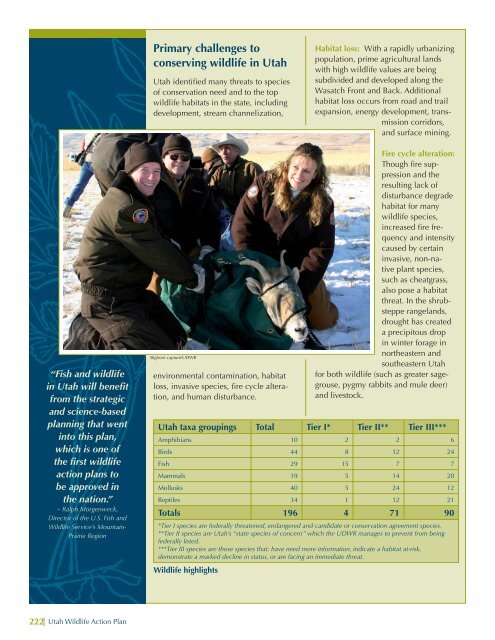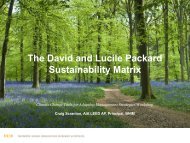State WAP Revised 8.29.06.indd - Teaming With Wildlife
State WAP Revised 8.29.06.indd - Teaming With Wildlife
State WAP Revised 8.29.06.indd - Teaming With Wildlife
Create successful ePaper yourself
Turn your PDF publications into a flip-book with our unique Google optimized e-Paper software.
Primary challenges to<br />
conserving wildlife in Utah<br />
Utah identified many threats to species<br />
of conservation need and to the top<br />
wildlife habitats in the state, including<br />
development, stream channelization,<br />
Habitat loss: <strong>With</strong> a rapidly urbanizing<br />
population, prime agricultural lands<br />
with high wildlife values are being<br />
subdivided and developed along the<br />
Wasatch Front and Back. Additional<br />
habitat loss occurs from road and trail<br />
expansion, energy development, transmission<br />
corridors,<br />
and surface mining.<br />
“Fish and wildlife<br />
in Utah will benefit<br />
from the strategic<br />
and science-based<br />
planning that went<br />
into this plan,<br />
which is one of<br />
the first wildlife<br />
action plans to<br />
be approved in<br />
the nation.”<br />
– Ralph Morgenweck,<br />
Director of the U.S. Fish and<br />
<strong>Wildlife</strong> Service’s Mountain-<br />
Prairie Region<br />
Bighorn capture/UDWR<br />
environmental contamination, habitat<br />
loss, invasive species, fire cycle alteration,<br />
and human disturbance.<br />
<strong>Wildlife</strong> highlights<br />
Fire cycle alteration:<br />
Though fire suppression<br />
and the<br />
resulting lack of<br />
disturbance degrade<br />
habitat for many<br />
wildlife species,<br />
increased fire frequency<br />
and intensity<br />
caused by certain<br />
invasive, non-native<br />
plant species,<br />
such as cheatgrass,<br />
also pose a habitat<br />
threat. In the shrubsteppe<br />
rangelands,<br />
drought has created<br />
a precipitous drop<br />
in winter forage in<br />
northeastern and<br />
southeastern Utah<br />
for both wildlife (such as greater sagegrouse,<br />
pygmy rabbits and mule deer)<br />
and livestock.<br />
Utah taxa groupings Total Tier I* Tier II** Tier III***<br />
Amphibians 10 2 2 6<br />
Birds 44 8 12 24<br />
Fish 29 15 7 7<br />
Mammals 39 5 14 20<br />
Mollusks 40 5 24 12<br />
Reptiles 34 1 12 21<br />
Totals 196 4 71 90<br />
*Tier I species are federally threatened, endangered and candidate or conservation agreement species.<br />
**Tier II species are Utah’s “state species of concern” which the UDWR manages to prevent from being<br />
federally listed.<br />
***Tier III species are those species that: have need more information, indicate a habitat at-risk,<br />
demonstrate a marked decline in status, or are facing an immediate threat.<br />
222 Utah <strong>Wildlife</strong> Action Plan





